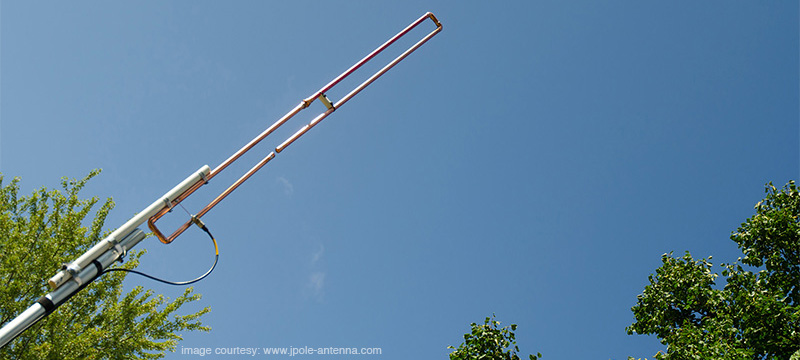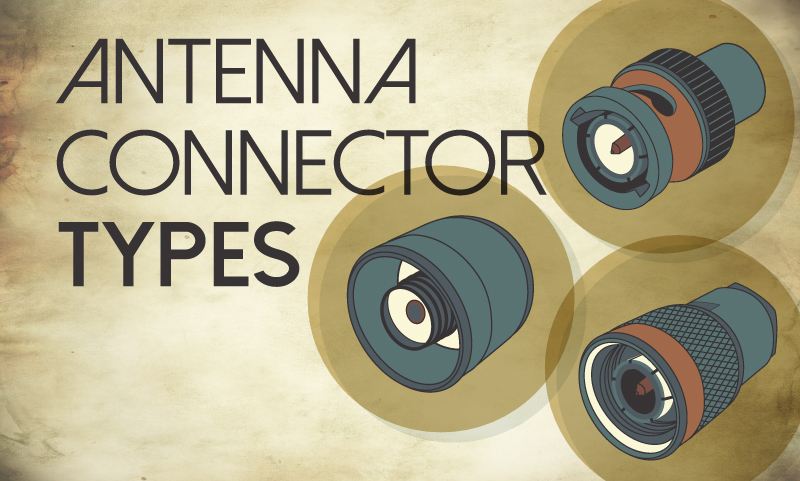
As a new Amateur Radio licensee, one of the major confusions I had while researching my first radio was understanding the various antenna connector types used by radio manufacturers. To those already ‘in the know’ the distinctions may seem obvious, but to a new Ham they tend to all look the same. And, really, antenna connectors do all share similar features, which is why it took me a few ‘online ordering’ mistakes and a little bit of research to really learn the difference.
At the time, I couldn’t find many clearly written articles outlining which connector is generally used in what application, so I’ve decided to take some time to describe them all here. Below you will find a description of all of the major antenna connector types along with a short history, common uses, and key features. I hope it helps! And if you feel I’ve left something out or want further explanation, please feel free to comment below.
Amateur Radio Antenna Connector Types
SMA (SubMiniature Version A)
Let’s start with the first connector you are likely to come across as a new ham–the SMA. The SMA is a lightweight, all-purpose connector that is particularly practical for smaller applications like handhelds. It can effectively carry signals ranging from 0-18 GHz (well outside the range of most Ham operations!) and utilizes a threaded connection, which is one of the most secure connection types. As is the case with a great deal of radio equipment, the SMA was designed to satisfy military requirements, so even for it’s small size it provides a very strong connection.
The SMA was developed around the 1960’s in an effort create a simple connection interface for RF coaxial cable. Its creation was most likely in response to the development of the 75 Ω ‘F Connector‘ early in the 1950’s, which is most commonly used for television applications. In fact, as a word of warning to new Hams, make sure to not confuse the two! Both the F Connector and SMA connector look rather similar–the main difference, other than their dimensions, is their impedance. The standard impedance for an amateur radio setup is 50 Ω, while the F Connector is 75 Ω. Attempting to mate a 75 Ω connector to a 50 Ω antenna will yield less than desirable results!
The most common place you will use an SMA connector now is on recent handheld/HT radios. Their small size is often more practical than the previously popular BNC connector, and the design of the threading makes it very difficult to cross-thread. The vast majority of aftermarket handheld antennas use SMA, so purchasing a radio with this type of connector is pretty safe. The SMA connector will probably be the standard for quite a few years.
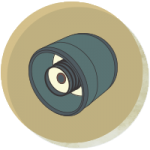 Female SMA
Female SMA
The Female SMA is the exact same interface as the SMA, however its use in certain handheld radios makes it incompatible with most standard antennas (without adapters, of course.) ‘Female SMA’ is the term used the ‘switching’ of the male and female parts on the radio and antenna. With a standard SMA the male ‘post’ is on the antenna–Female SMA is opposite. It is NOT the same as RP-SMA (reverse polarity SMA), which reverses the external housing. Female SMA uses all the same parts. In fact, you can take a Female SMA antenna and a standard SMA antenna and thread them both together.
For the most part the Female SMA radio is exclusively a Chinese radio manufacturing phenomenon, coming from brands like Baofeng, Leixen, and Yanton. While manufacturers of these handhelds are still very much in the minority, aftermarket antennas are relatively easy to come by. All of the major ham radio antenna manufactures have a Female SMA option available (see the ARTech Antenna Selector for more options!)
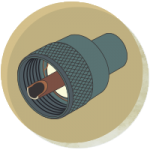 UHF Connector (PL-259 and SO-239)
UHF Connector (PL-259 and SO-239)
The next type of antenna connector you’ll come across in your amateur radio journey is the UHF connector. These are installed on most mobile radios and HF base rigs. They’re old school–dating back to before World War II. In fact, it’s precisely due to the fact that everything down to 30 MHz was considered UHF back then that this connector system was called a ‘UHF Connector’! Often times you’ll hear it referred to as a PL-259 connection, and that’s because the PL-259 (think: ‘plug’) is the male component of the system, with SO-239 (think: ‘socket’) being the female.
The UHF connector has received a great deal of scrutiny in the recent past, brought on in part by some independent testing that has shown a significant performance loss at frequencies above 50 MHz. In an eye-opening article on hamradio.me, John Huggins, KX4O, reveals multiple repeatable test results which show a great deal of signal loss in the UHF connector compared with other connectors. Huggins concludes, “The question is not if the UHF Connector has more loss than modern connectors, but if this loss matters in your system.” Take away: if you’re looking for a high-performance, near-lossless connection on VHForUHFapplications, you should probably look elsewhere.
 Type N
Type N
Discussions about the UHF connector’s shortfalls will invariable lead to the ‘Type N’ system. Named after Paul Neill of Bell Labs, the Type N is perhaps the most versatile and mechanically sound of the antenna connector types available today. It was developed in the 1940’s for military use, and today it can handle frequencies up to 11 GHz. By employing a rubber gasket in the seat of the male casing, the Type N creates a waterproof connection point.
Because of its waterproof and mechanically sound qualities the Type N connector is most often used in Base Station setups or repeater installs; however, a growing number of Hams are replacing the UHF connectors on their mobile radios with aftermarket Type N connectors. From what I’ve heard, some or many of the European version mobile radios have been equipped with stock Type N connectors, a sign that manufacturers recognize it’s superior performance but that Americans are simply not quite ready for a complete transition. Long story short, the Type N connector is the best of the bunch, and as a whole, we should probably start using them more often.
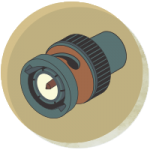 BNC (Bayonet Neill–Concelman)
BNC (Bayonet Neill–Concelman)
Remember Paul Neill from the Type N connector? That’s the same guy who helped create the BNC connector. The BNC was created in the late 1940’s to accommodate for smaller radio applications, especially those being used by the military. Its Bayonet connection is its greatest strong point–a positive lock can be achieved with a mere quarter-turn. Unfortunately it is rather larger and less mechanically sound compared to its competition, the SMA. Perhaps for that reason it has seen less popularity in the past several years. Some handhelds like the Icom V-80 are still being made with the BNC connector, however the vast majority are now using SMA.
The BNC does come in both 50 Ω and 75 Ω models, so it’s important to know what connector you are working with, especially because they will often mechanically match one another, and visually they can be very similar. As for its ability to carry signal, it depends on your application. As long as it is intended to be used under 4 GHz, as is the case with most Ham uses, there will be no issues. Because of its bayonet style sheathing, the BNC can have issues at frequencies about 4 GHz.
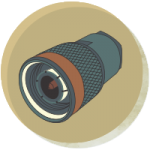 TNC (Threaded Neill–Concelman)
TNC (Threaded Neill–Concelman)
The TNC connector is exactly the same as the BNC except that it is threaded. It is certainly less common, but its threading makes for a more mechanically secure connection. Because of its threading, it is capable of carrying signals with much higher frequencies than the BNC, up to 11 GHz. A 75 Ω option is available, but most TNC you come across will be 50 Ω. I’ve never actually seen a TNC connector used in an amateur radio application, so please share a photo if you are using it!
The Long and The Short
If you’re a new Ham the number of antenna connector types regularly used throughout the industry can be overwhelming. My advice to you is this: don’t pick a first radio because of it’s connector–pick a radio based on the features it will provide for you and based on its ease of use. There is a workaround for just about any connector your radio comes with, and usually an adapter will cost you less than $5.00. It’s easy to get wrapped up in purchasing ‘the perfect setup’, but recognize that you’ve got the rest of your life to perfect your radio collection!
Hopefully this post has been helpful for you and has clarified some of the uses and backgrounds of the antenna connector types that are used every day in your ham shack or on the repeater in your neighborhood. If you’d like to provide some feedback please leave a comment below–I’d love to hear from you! I’m still a student, myself, and will gladly learn from the folks who have been on the air much longer than me! 73!




